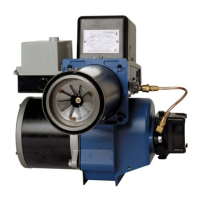
Do you have a question about the Wayne HS and is the answer not in the manual?
Company address, phone, and fax information for Wayne Combustion Systems.
Firing capacity, electrical requirements, fuel types, and dimensions of the HS oil burner.
DANGER and WARNING statements regarding burner installation and operation.
Guidance for homeowners on burner operation and recommended service.
Definitions and explanations of DANGER, WARNING, CAUTION, and NOTICE symbols.
Detailed specifications including firing rate, fuels, electrical, and dimensions.
Critical safety advice on electrical shock, overheating, fuel use, and installation risks.
Ensuring adequate space, clean flue passages, and proper chimney setup.
Requirements for combustion chamber type, size, and installation details.
Guidelines for fuel pump operation, fuel lines, and filter requirements.
Regulations for fuel tanks and air supply for combustion.
Recommendations for chimney design and draft regulator installation.
Step-by-step instructions for safely removing the gun assembly.
Proper procedures for installing and handling burner nozzles.
Correct spacing and alignment for burner electrodes for reliable ignition.
Instructions for correctly installing the gun assembly into the burner.
Procedure to calibrate the air cone position for optimal combustion.
Wiring guidelines and compliance with electrical codes for burner installation.
Steps to follow for the initial startup of the oil burner.
Adjusting air and fuel for optimal combustion efficiency and low smoke.
Using CO2 and smoke readings to achieve efficient combustion.
Verifying all settings, controls, and connections are correct after adjustments.
Routine maintenance including motor oiling, filter, and nozzle replacement.
Procedure and spacing checks for blower wheel and motor replacement.
Information on mounting positions, vacuum checks, and pump installation.
Correct procedures for checking pump and nozzle pressures.
Wiring diagrams for the solenoid oil valve and its connection.
Instructions for setting up a one-pipe fuel system, including bleeding.
Guidelines for installing two-pipe fuel systems with bypass plug.
Table detailing maximum line lengths for two-stage, two-pipe systems.
Guidance on selecting nozzle types, sizes, and spray angles.
Table showing how pressure affects nozzle flow rates.
Suggested spray angles for different combustion chamber types and sizes.
Features of the 101343-SER oil primary control, including recycle and lockout.
Interpreting diagnostic LED states and checking cad cell resistance.
Timing parameters, input/output electrical ratings, and wire color codes.
Operating ambient temperature, humidity, and agency approvals.
Illustrated parts list for the HS model burner with part numbers.
Specific parts breakdown for the gun assembly.
Safety precautions for handling kerosene, including vapor hazards.
First aid procedures for inhalation, skin, eye contact, and ingestion.
Terms and conditions for oil and gas burner limited warranties.
Limitations, exclusions, and implied warranty disclaimers for burner products.
